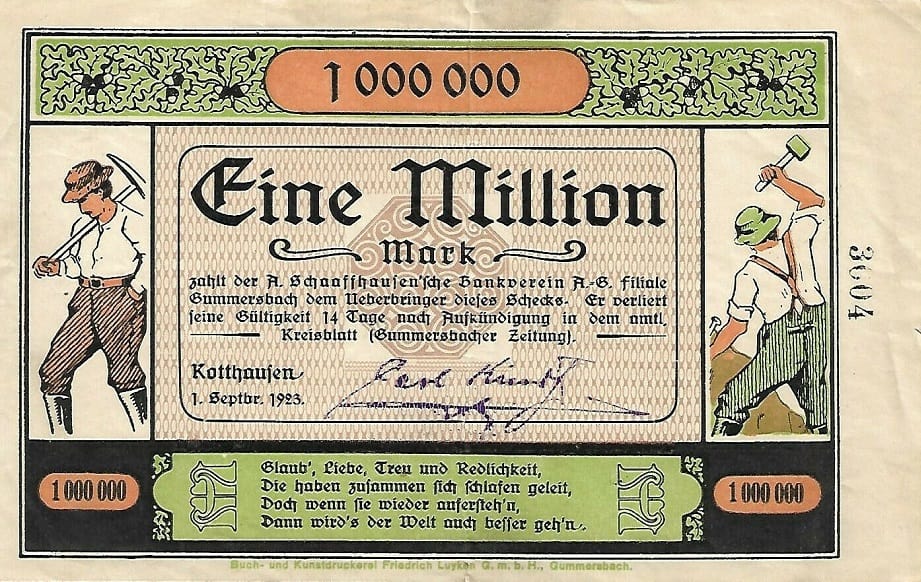This was the era when the money system, hit with crippling hyper-inflation, went crazy………….and eventually collapsed. At the peak, in October 1923, Germany experienced a 29,500% hyperinflation rate (roughly 21% interest per day)!!
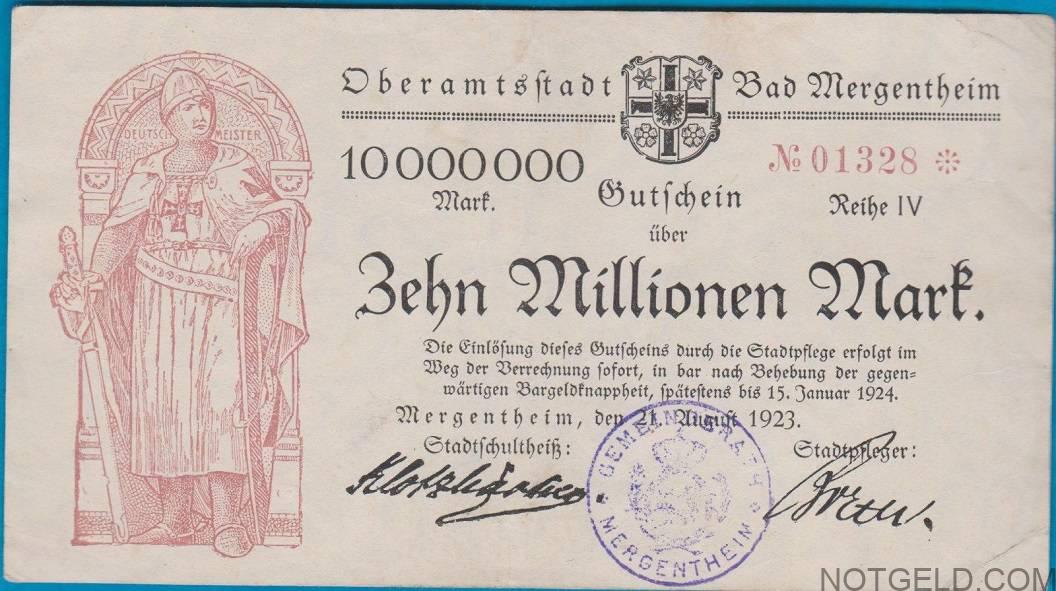
For reference : in 1921 a loaf of bread was 1.35 marks : in 1923, at the beginning of……………and at the height of ………….. the hyper-inflationary period, when prices had totally run out of control, a loaf of bread which cost 250 marks in January had risen to 200,000 million marks in November!! (200 milliarden mark).
The following scan of 3 notes all show a ‘private’ issue from Bremen, with a face value of 5,000,000m. Top note has a hand-written date, 2nd note has been hole-punched cancelled (but not usual circle shape) and the 3rd note has been hole-punched cancelled (‘BEZAHLT’) but also very unusual indeed, has also got a hole-punched date!! – ‘27.9.1923’. It is the first notgeld piece I have ever come across with a date like that!!
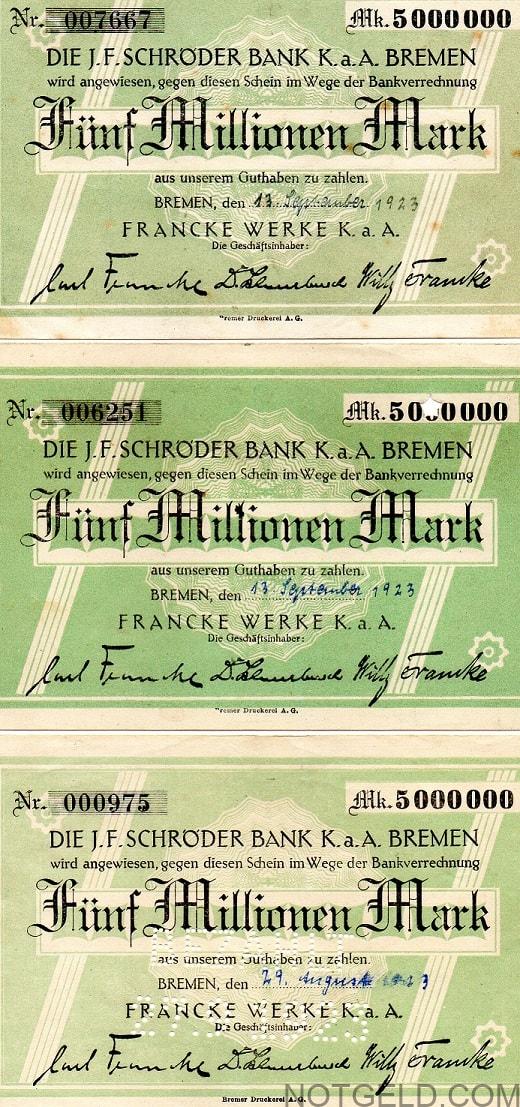
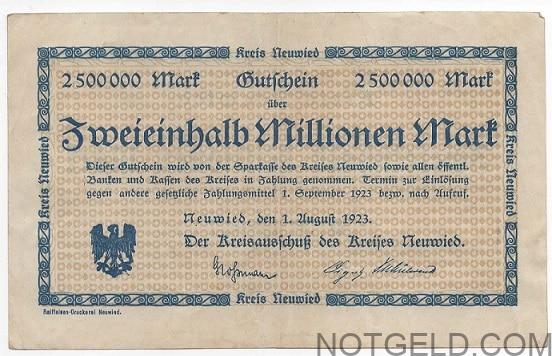
The peak of the hyper inflation period in Germany was late 1923. Notes were being issued with face values of Billions of marks! The note above for 2.5 million, is unusual as a face value. (They would usually issue pieces with face values like 100,000 : 500,000 : 1,000,000 : 2,000,000 : 5,000,000
- 1,000,000 – 1 million
- 10,000,000 – 10 millionen
- 100,000,000 – 100 millionen
- 1,000,000,000 – 1 milliarde (1000 million)
- 10,000,000,000 – 10 milliarden
- 100,000,000,000 – 100 milliarden
- 1,000,000,000,000 – 1 billion (1000 milliarde……..the same as ‘a million million’!)
- 10,000,000,000,000 – 10 billionen
- 100,000,000,000,000 – 100 billionen
- 1,000,000,000,000,000 – 1 billiarde
- 1,000,000,000,000,000,000 – 1 trillion
- 1,000,000,000,000,000,000,000 – 1 trilliarde
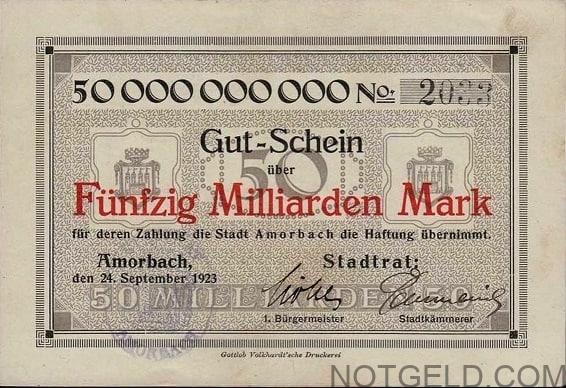
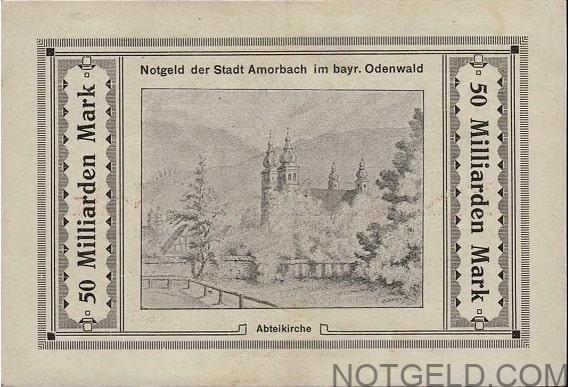
It’s nice sometimes to see a note with the face-value in words and numbers!!
The note below, has the word ‘scheck’ on it (cheque). It’s format is similar to the modern day cheques. It was issued in Oberhausen and is dated September, 1923. Just like the Reichbanknotes (issued by the state), notgeld issues began to be affected by the runaway inflation that Germany experienced during this period. By late 1923, notes were being issued in Billion Mark denominations – in Germany this was equal to 1,000,000,000,000! There were many issues, (see under the ‘introduction’ tab on the homepage) and many were from private companies, as can be seen by the scan above.
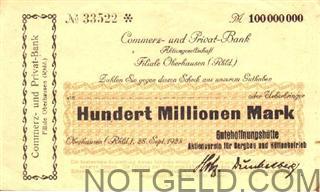
Pre 1914; 1$ = 4M…….Nov.19th 1923; 1$ = 4,200,000,000,000M)!!!!!
Some of these hyper-inflationary issues can be fairly plain, but others like the note below, issued in Bamberg and dated ‘Nov.1923 are absolutely beautiful in design. All true German Billion mark notes from this period will have the word Billion or Billionen on them. 1,000,000,000 was not a Billion, but a Milliarde (1000, millionen). A Billion was 1000 Milliarde!
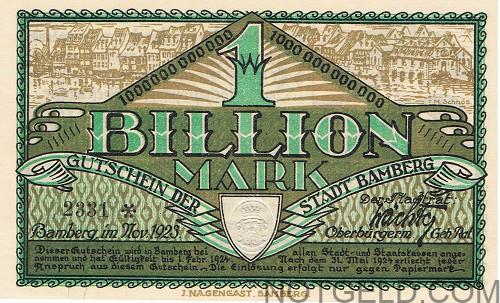
The highest face-value notgeld was issued in Crefeld. It had a face value of 200 BILLION marks (200,000,000,000,000m!!). The picture below is a faxsimile:
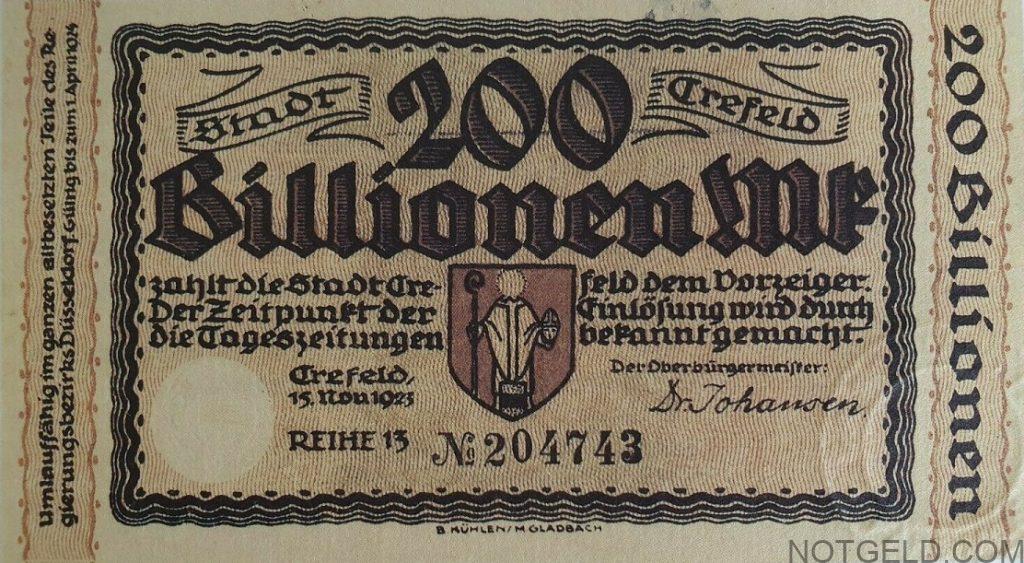
Many people have heard the stories of people taking barrow loads of money in the form of these hyper-infltion issues with them to purchase something. The wheelbarrow was sometimes stolen, with the paper money just tossed all over the floor. The barrow was worth more than all the money in it! Below, is a lovely looking hyper-inflationary notgeld piece from Saulgau:
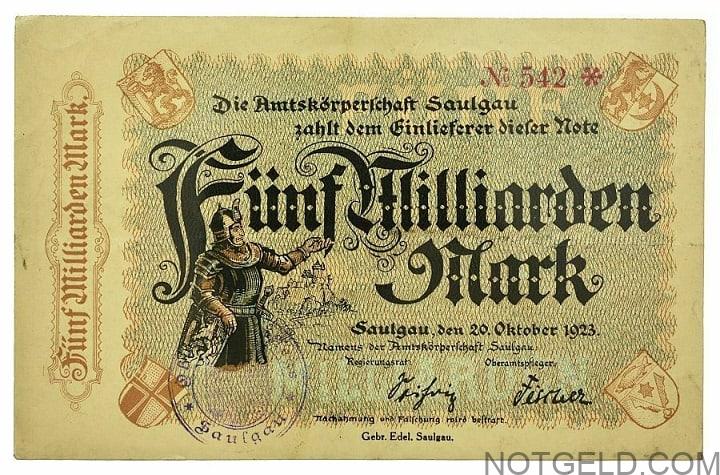
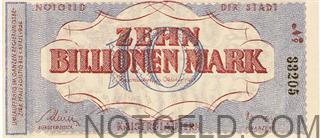
The 10 Billion mark note above is from Kaiserslautern and is valid until 1 April 1924. In the centre of the note (under BILLIONEN MARK) is the date of issue, 10 Oktober 1923.
The German Inflation period, depicted by the ‘egg story‘ and a bread roll comparison
The price of an egg:
- At the end of WWI, a housewife had to pay 25 pfennigs for an egg. (She could do this with one small coin from her purse).
- Four years later – in the autumn of 1922 – she already had to take many notes from her purse to pay the price of 180 marks.
- In November 1923 when inflation reached its peak, she had to bring a big basket full of notes to pay 80 Billion Marks (80,000,000,000,000) for one egg!
- In 1918 you would have got 320 Billion eggs for 80 Billion marks. So back then, that would have been enough to easily give every inhabitant of Germany (approx 61 million people in 1918) an egg for breakfast………… for over 10,000 years!!! ………….ABSOLUTELY MIND-BLOWING!!
Here is another example:
- On 24th May 1923, a 50g bread roll would have cost you 100 marks.
- On 15th July 1923, a 50g bread roll would have cost you 800 marks.
- On 15th November, a 50g bread roll would have cost you 12,000,000,000 marks!!!
*************************************************************************************
Some famous names and companies issued hyper-inflationary notgeld issues. The company ‘Carl Zeiss’……a German manufacturer of optical systems, lenses and industrial measurement and medical devices, founded in Jena, Germany, in 1846 by optician Carl Zeiss, issued the notgeld below. Carl Zeiss was born in 1816 and died 1888 and is buried in Jena, the town of issue………….
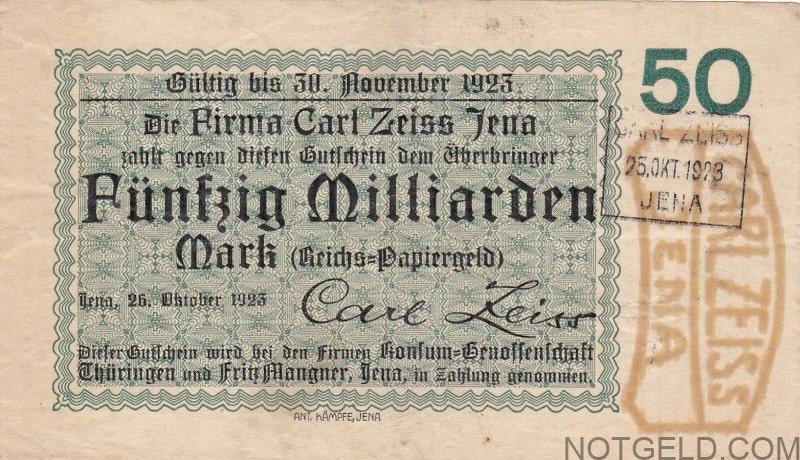
Nearly everyone will have heard about the famous German Steiff teddy bears. Below is a banknote from Giengen and issued for the company….. with the teddy-bear logo:
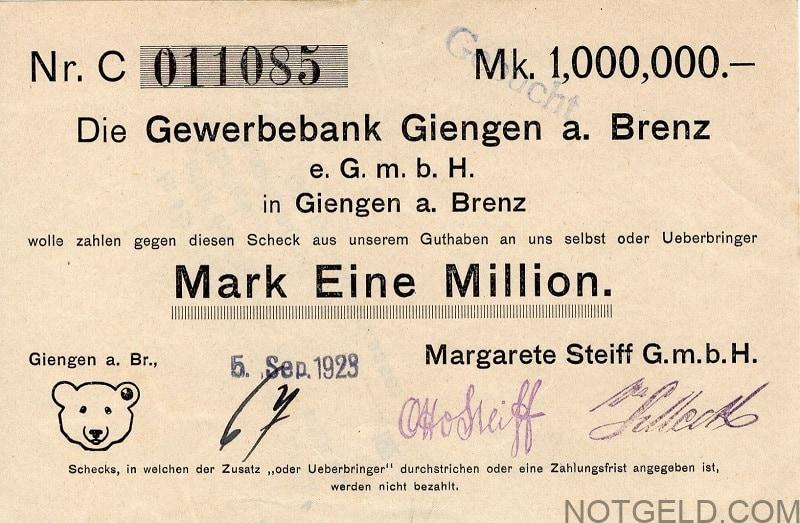
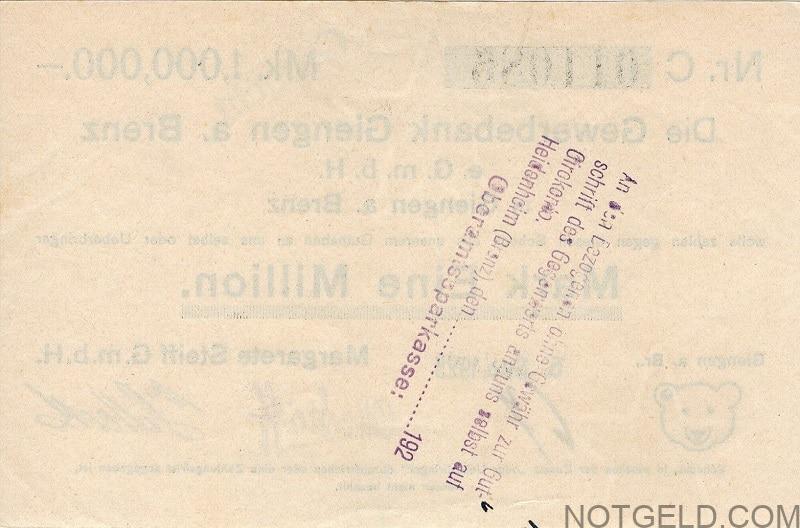
The following note is from the famous car manufacturer:
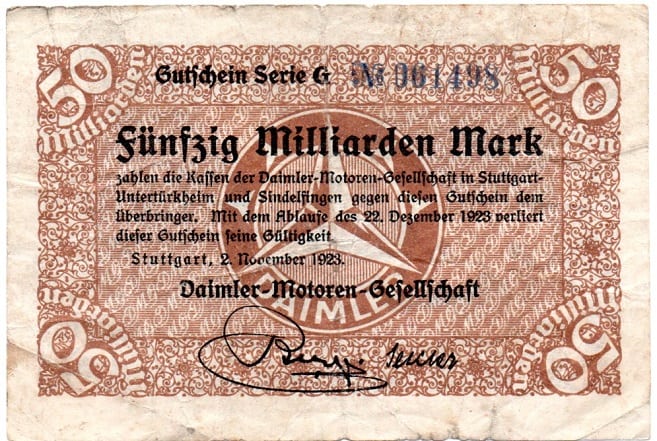
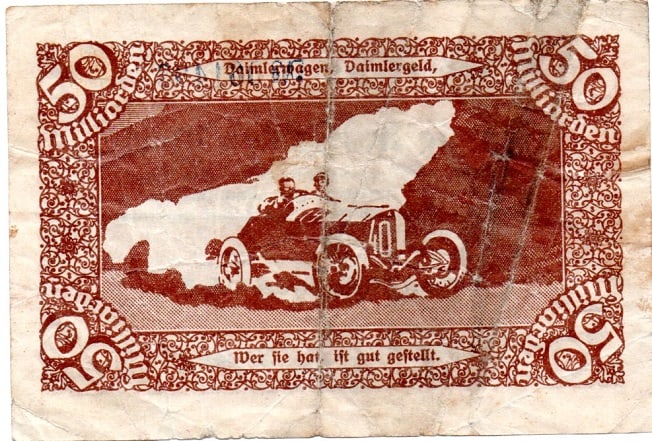
Most of these notes issued by companies would be for 1 single company name The following piece from Hamburg, however, was issued by some Insurance corporations or companies from Hamburg – see the names on the reverse side……

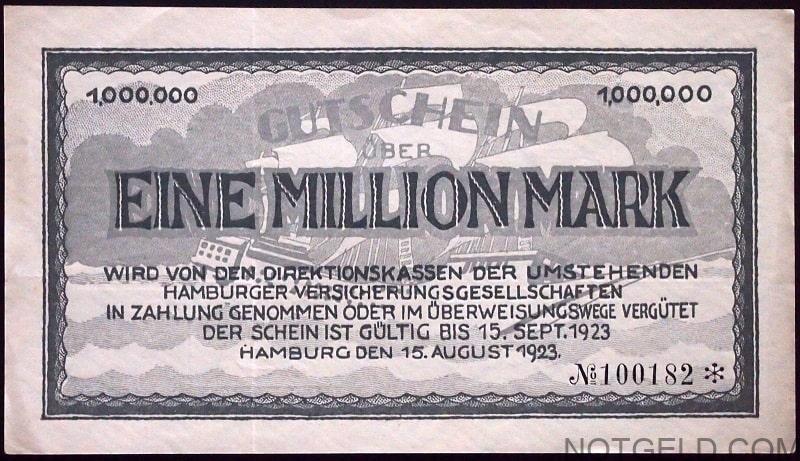
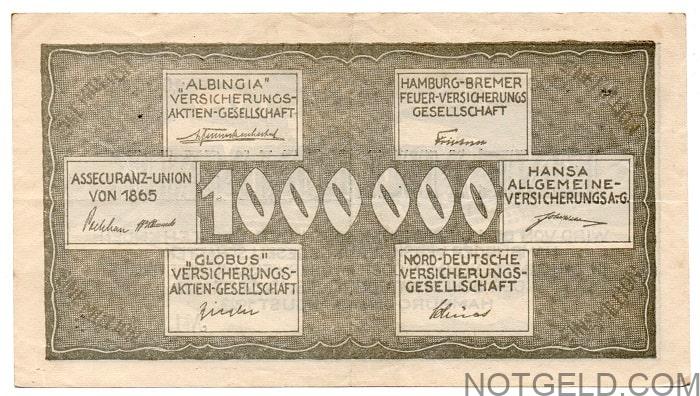
Here is a nice note for a collector – an inflationary notgeld from Haslach, Hausach, Schiltach & Wolfach with hand-written serial number! The note also has, unusually, 4 different signatures for the 4 burgermeisters (mayors) of the 4 towns/villages.
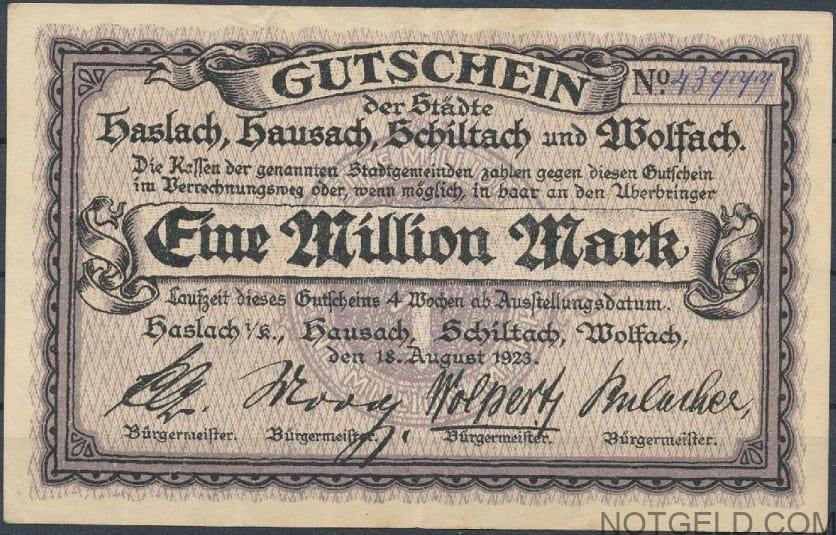
Private specimen (musterscheine) note.
The following scan is of a rare specimen note, issued by ‘Weserwerke G. & F. Kaminski AG’ of Hameln. (Georg & Franz).
This company name was in existence from 1923 – 1929. The company exists today and is called ‘Franz Kaminski Waggonbau GmbH’.
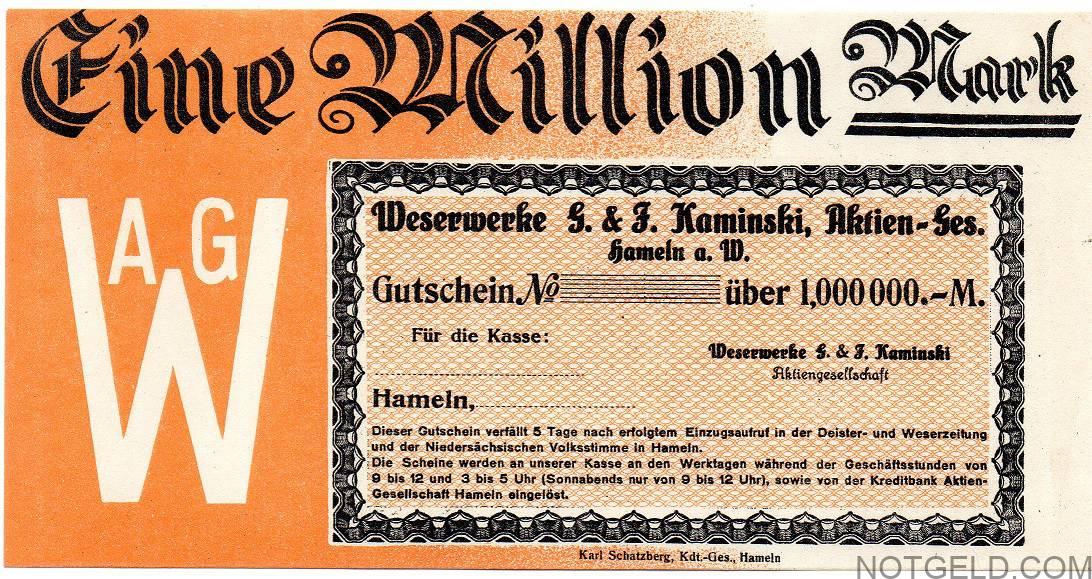
Print error!!
Below, is a scan of a very unusual Inflation piece of notgeld, issued in Memmingen (28 Oktober 1923). It is a printing error or ‘fehldruck’ piece.
10 milliarden or 20 milliarden??

(Here is the normal note)!
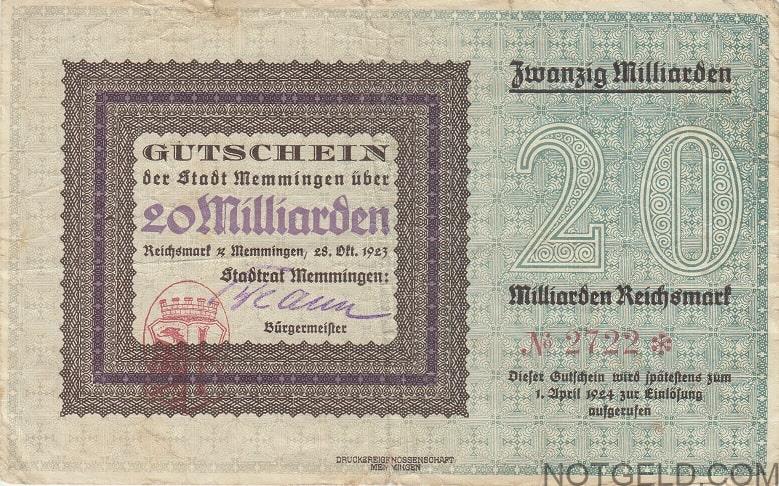
Look out for notes that have nice imagery. They look fantastic in a collection. Below, are 2 examples of the imagery for the ‘Phoenix rising from the flames’, issued by the Phoenix company in Dusseldorf……on a 100,000m note and a 50 million mark note. There is a difference in the wing shape and position………………………..
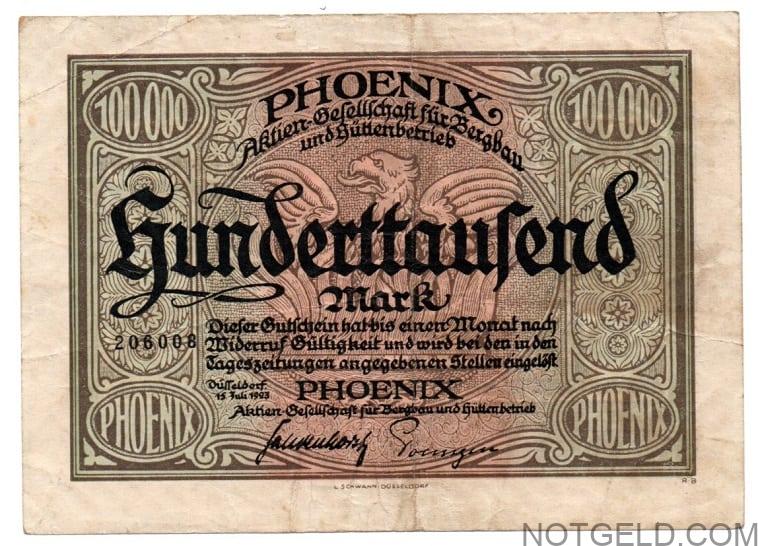
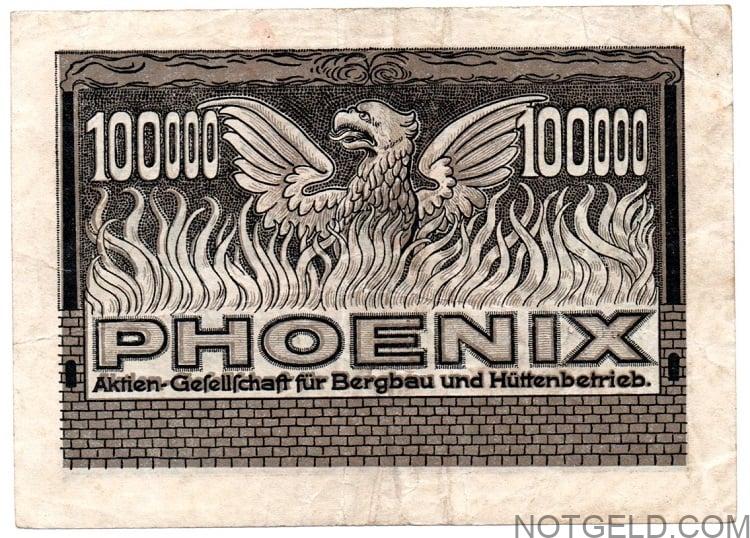
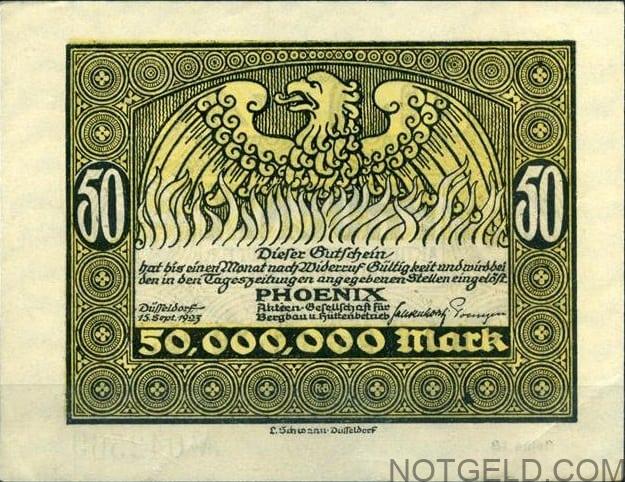
“Bergbau und Huettenbetrieb” translates as Mining and Smelting Works.
The Phoenix Mining and Smelting Works Ltd was founded in 1852 in Eschweiler near Aachen, with the intention of mining both iron ore and coal to smelt and turn into pig iron, keeping the whole process in house, as it were, from raw materials to finished product. It had various plants along the Rhine. The company moved to Duesseldorf in 1921-1922, just before the issue of its inflationary notes.
One of its former steelworks, Phoenix East in Dortmund, was excavated and flooded and turned into an artificial lake in 2006.
Below is another example of the notgeld they issued, this time from the city of Hoerde.
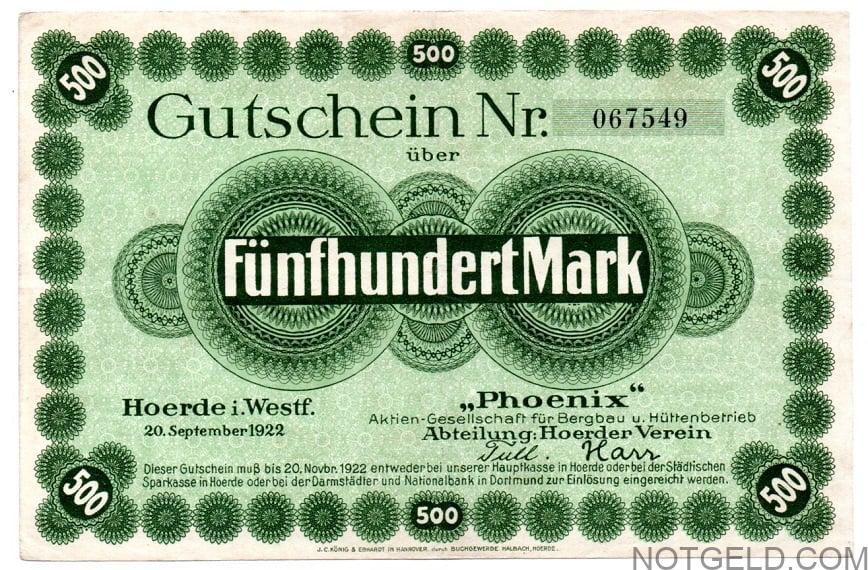
Below, is another interesting face-valued hyper- inflationary notgeld, from Riedlingen. Issued in Oktober 1923, it has a face value of 250 milliarden (250 thousand millionen) mark (250,000,000,000m)………..that’s 1/4 of a BILLION.
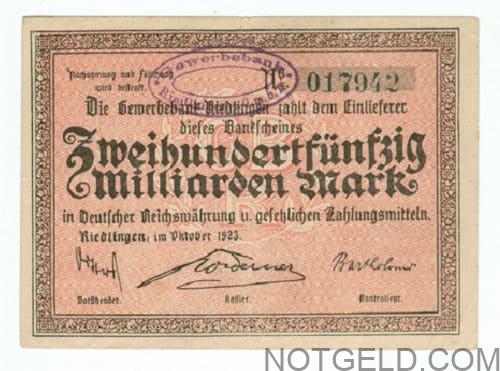
The following pinkish coloured note, below, was issued in Kaiserslautern and has a date of ’15 August 1923′. They issued 50,700 pieces of this face value note, which had a combined face value of 10,140,000,000m!I only know this because of the envelope shown under the actual notgeld piece, which details the different notgeld issues from the town of Kaiserslautern for the year of 1923. An interesting notgeld collector item.
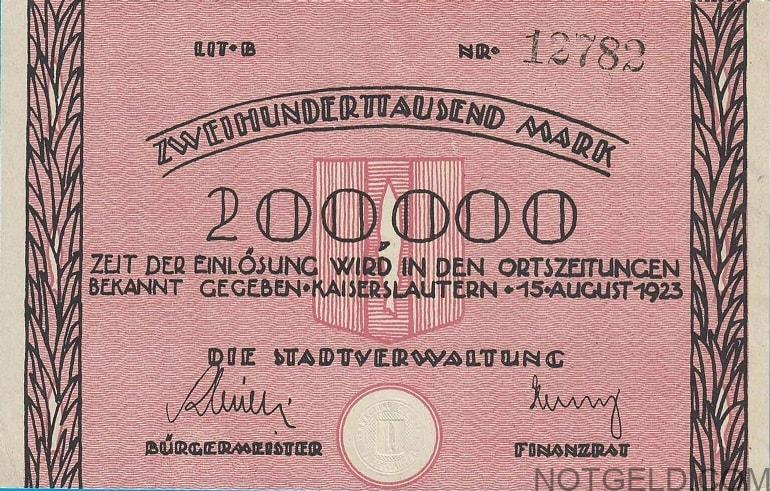
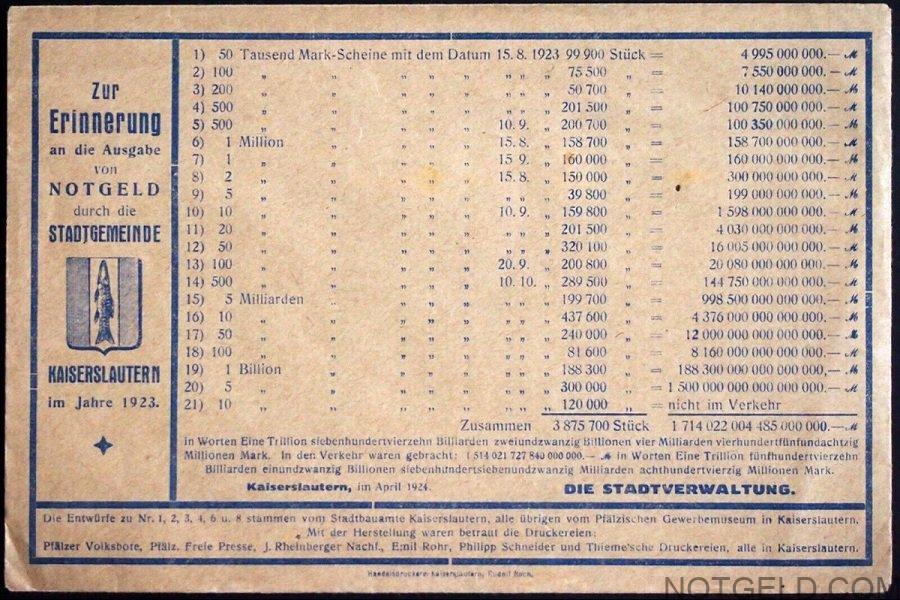
The following piece is just, what I would call, a lovely example of an Inflation 1923 piece of notgeld. You can quite easily see the town of issue, the serial number (hand-written in this example), the face-value of the note, the date of issue and a valid until date, an official stampmark and a signature (again, hand-written in this example). The paper colour of green, also makes this note ‘interesting’.
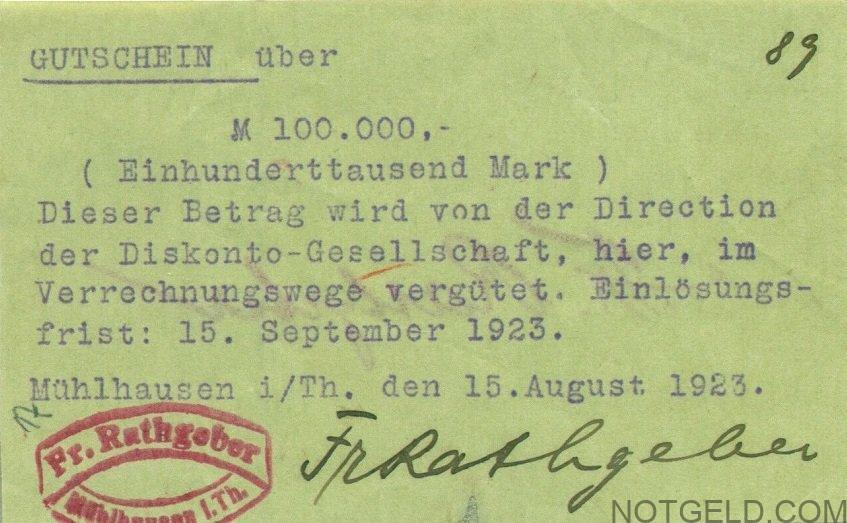
…..and another good example from Anklam
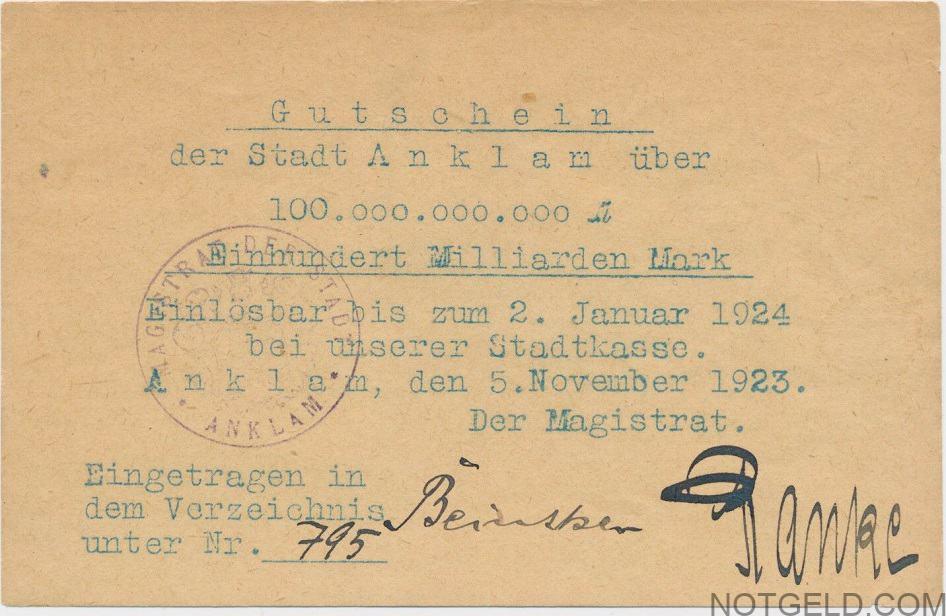
An unusual ‘ vertically designed’ note from Hattingen-Ruhr
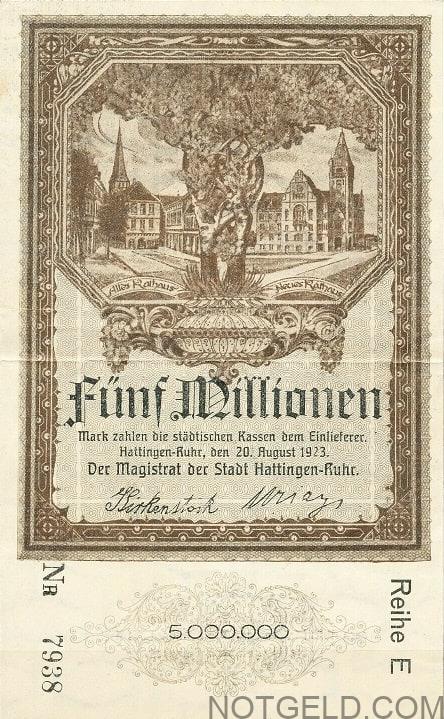
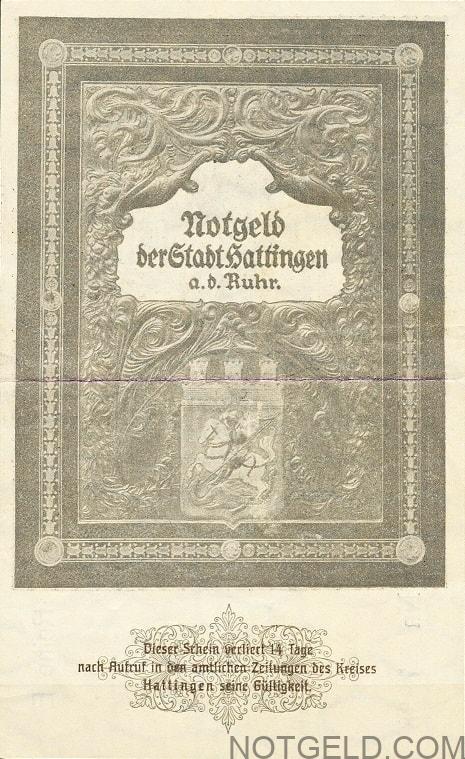
Often collectors with come across notes that have been cancelled in some way…….corner-cut, stamped, hole-punch cancelled. Here is a good example!!
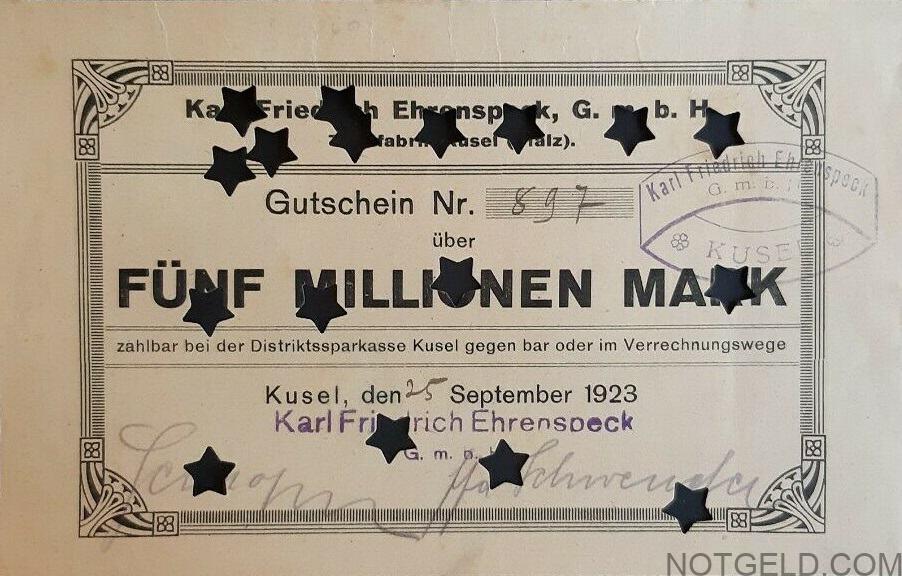
I am always on the look out for beautiful looking notes that one doesn’t come across day-to-day, so I can add the scans to my notgeld articles, so that my website visitors get to see them too. Here is what I think is a great looking note from Kotthausen.
